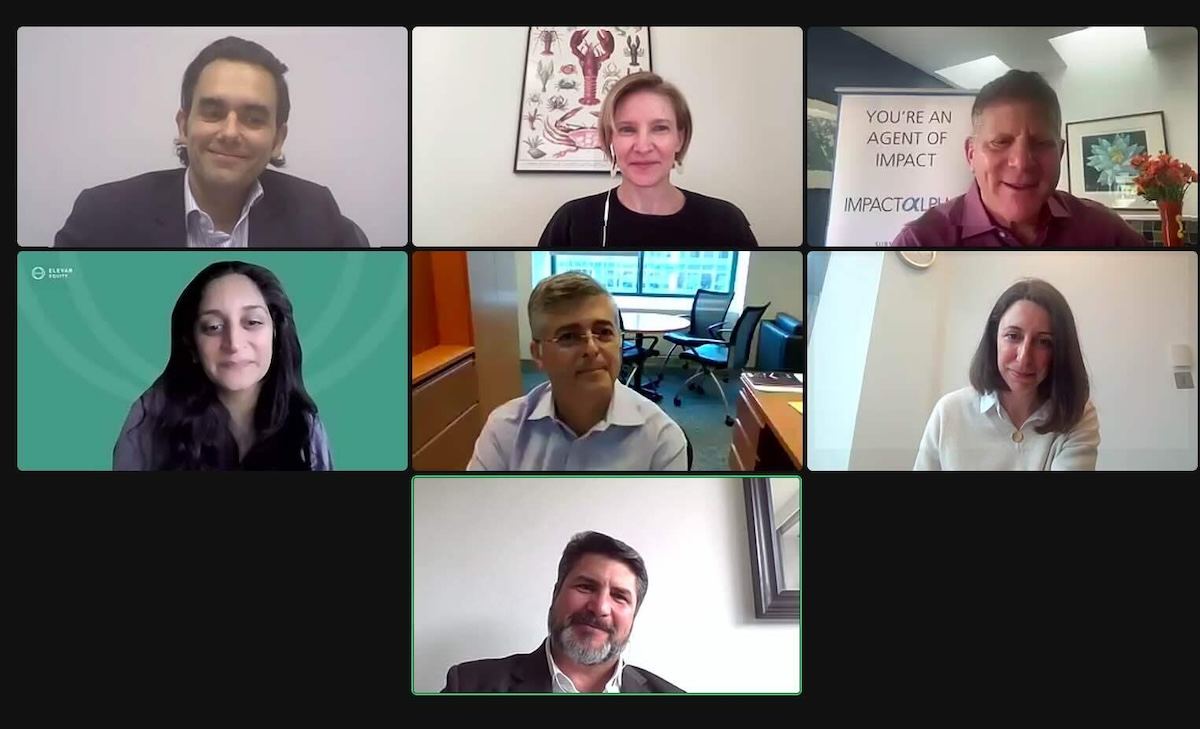Capital into emerging markets is often stalled by international investors’ perceptions of risk—usually because of political issues, conflict, or local and macroeconomics.
People within each market nevertheless continue with day to day life, regardless of their political or economic circumstances. Emerging market households, especially those in lower or middle-income bands, collectively spend trillions of dollars on daily necessities, their livelihoods and securing their families’ futures.
The “Inclusive Business Investing Guide,” published by the International Finance Corp., British International Investment and Dutch development bank FMO aims to activate more and more intentional capital into products and services that improve emerging market consumers’ lives and enable them to build financial resilience and wealth. ImpactAlpha combed through the guide to distill the key takeaways.
Who ‘inclusive businesses’ serve
Half of the world’s population lives on less than $7 per day (and more than 85% live on less than $40 per day). The guide defines “inclusive businesses” as those with a mission to provide financial services, healthcare, education, energy access, livelihood support and other necessities to lower-income consumers.
Target income demographics will vary from businesses to business and market to market. “Common thresholds include fixed global lines of $6.85, $8.44 or $12 per day per capita in purchasing power parity,” the guide states. Or, businesses could use “a variable line that reflects the bottom 40 or 50 percent of people in a country based on consumption.”
Often women, Indigenous people, people with disabilities, and marginalized ethnic and racial groups form a disproportionate share of lower-income populations because they have been excluded from or underserved by mainstream markets.
How they generate returns
Everyone needs to eat, communicate and exchange money or goods. Most people prioritize basic ways to live safely and comfortably, with lighting, access to clean water, and heating in their homes, and to improve their families’ future prospects, by putting aside savings, sending their children to school, or investing in their own knowledge and skills development.
Inclusive businesses generate revenues and make profits by selling goods and services that customers need and otherwise can’t access, or by providing better products and services that are otherwise available.
Rwanda-based Ampersand, for example, finances and sells electric bikes for motorcycle taxi drivers. In India, Altum Credo provides mortgages for first-time homebuyers underserved by other financial institutions.
Financial returns for inclusive businesses can also come from “improved productivity and output of workers [and] the value they provide to supply chain partners.”
Investment thesis alignment
Investors will have different motivations for investing in inclusive businesses. Climate investors, for example, may find that inclusive businesses are helping ensure the green transition is a just transition by ensuring that people from all income brackets have access to products, services and infrastructure that support their climate resilience. (p. 21)
Diversity-focused investors may look for businesses that are creating job and career growth opportunities for women, youth or historically disadvantaged groups.
Real estate and housing investors may search for opportunities supporting community ownership, green affordable housing, and new pathways for homeownership among underserved demographics.
Regardless of investors’ thesis or sector focus, to deepen their investments’ impact for underserved households, they should consider:
- What risks and challenges face these consumers within investors’ focus sectors and geographies? Perhaps customers are wary of buying new products and technologies, or they have low levels of literacy or language barriers. Maybe there are products and services in the market but they aren’t adequately addressing underserved customers’ needs. Maybe there are digital or infrastructure obstacles for reaching underserved customers. Perhaps suppliers of the needed products and services themselves lack access to financing or smooth logistics. (p. 18)
- Can an inclusion lens be embedded in existing sector and geographic focus areas?
- How does an inclusion lens support investors’ impact on their existing demographic targets?
- How can investors’ capital influence portfolio companies’ inclusivity work (for example, can new down-market products and services be added?)
Screening and due diligence
When looking for investment opportunities aligned to investors’ inclusion strategy, investors should:
- Understand the business’s target market and business case for inclusion. Underserved stakeholders “should have a material role in the core business,” the guide suggests.
- Interrogate whether and how products and services are designed for inclusivity. “The company should implement a solution that creates value and addresses a need among [underserved] stakeholders.”
- Help businesses establish or augment impact measurement and management processes. The Impact Management Project’s five dimensions of impact are a good starting point: what, who, how much, contribution, and risk. They can also set thresholds for their portfolio companies to work towards, like a percentage of low-income customers.
- Consider how investors’ can support businesses’ talent development (p. 22)
Reliable or current data on underserved households isn’t always available for many markets. There are a wealth of data proxies investors can use to diligence whether a potential investee is reaching underserved customers and households, such as customer livelihood data (whether customers are low-wage or gig workers, small or informal shop owners, or rickshaw or motorcycle taxi drivers.) Or customers’ level of access to water, power or internet connectivity. Or even the distribution channels a business is using to reach its customers, such as mobile wallets or rural field agents. (p. 16)
Other important diligence questions to ask:
- How much of the company’s purchasing comes from low-income suppliers, and how many such suppliers do they source from?
- Does the company offer capacity building, financing, inputs, or other support to help its low-income suppliers overcome barriers?
- What number or percentage of the company’s workers are considered low-skilled?
- Is there evidence of workers’ incomes increasing?
- Does the company tailor its distribution practices or channels to better reach low-income distributors or retailers?
- Does the company offer a product or service that is specifically designed, packaged, priced, or targeted for low-income customers to increase affordability or accessibility, including uptake? (Note that such products may be attractive to other customer segments as well.)
- How much of the company’s sales or portfolio do low-income-focused products or services represent? (More on p. 27)
Value creation
Investors consider how investees or potential investees can boost inclusion adding value to both the company and its customers. For example, for companies grappling with product/service awareness challenges among target customers, what education or training could be provided to increase uptake and use of products or services? How can technology create new opportunities for outreach? (p. 29)
For businesses dealing with product/service affordability issues, are their hidden costs to the products and services? Are there opportunities to partner with a financial institution or fintech for customer credit or other forms of financing?
Clean cooking company Koko Fuel, agri-input supplier Mati Carbon, and solar irrigation company SunCulture are all tapping the carbon markets as a way of passing on cost savings for their products to lower-income and cash-constrained customers.
Where there are accessibility issues for customers, are there opportunities to reach, expand into or recruit from underserved communities? Off-grid solar, clean cooking and fintech companies often leverage networks of field agents, particularly female agents, to educate potential customers about their products while providing income opportunities for un- or underemployed groups.
Also: Could digital solutions be leveraged to expand access without excluding unconnected populations? Accion’s new Digital Transformation Fund is working to give traditional brick and mortar micro- and rural finance companies a tech upgrade to help them deliver new and better financial products to their customers.
How a deal is structured can also contribute to value creation. For example, a debt investor could require its loan to be used partially or exclusively for on-lending to underserved customers. (p. 33)
Roots of Impact works with social enterprises like Clinicas del Azucar in Mexico and investors like Root Capital to set up impact “bonus payments” to encourage organizations to expand services or offer new products and services to low-income customers. (Go deeper on how impact incentives are being designed and used by social enterprises, fund managers and limited partners.)
Impact management
Investors and investees should agree on what impact metrics to work on, to track, and frameworks to use before signing a check. “Who” is being impacted is particularly important for inclusion-lens investing. Tracking the number of new energy/water/broadband connections or loans to low-income households may be an important direct impact metric to capture. Companies may also impact their distributors, if they’re working with small or informal retailers, for example. How are these distributors’ earnings being affected? (p. 31)
Or workers: are portfolio companies hiring low-income or low-skilled individuals, and are these employees gaining access to new skills or promotions?
“Investors should follow best practice when establishing impact reporting requirements and refer to harmonized indicator libraries whenever possible, such as the IRIS+ platform or Harmonized Indicators for Private Sector Operations,” the guide advises.
British International Investments uses 60 Decibels’ Lean Data methodology to gather impact insights directly from customers of its portfolio companies and funds.
Technical assistance
Emerging markets are rife with obstacles for delivering products and services to rural, low-income and other underserved customers. Building economic inclusion in these markets often requires catalytic and concessional capital and technical assistance to help businesses develop new products, test market fit, forge distribution channels, and develop capacity within their teams and field agents.
FMO, for example, works with nonprofit TechnoServe and the Commercial Agriculture for Smallholders and Agribusiness Technical Assistance Facility, funded by the UK government, to build capacity among its agribusiness portfolio companies that work with smallholder farmers. The support helped DeHaat in India pilot an input finance scheme for farmers, and helped Tanzanian coffee trader Sucafina set up a loyalty-based financing program for its cooperative partners. The guide recommends several additional resources on technical assistance and capacity support: The GIIN’s “Beyond investment: The power of capacity building support,” and Endeva’s “More than money“ report.











